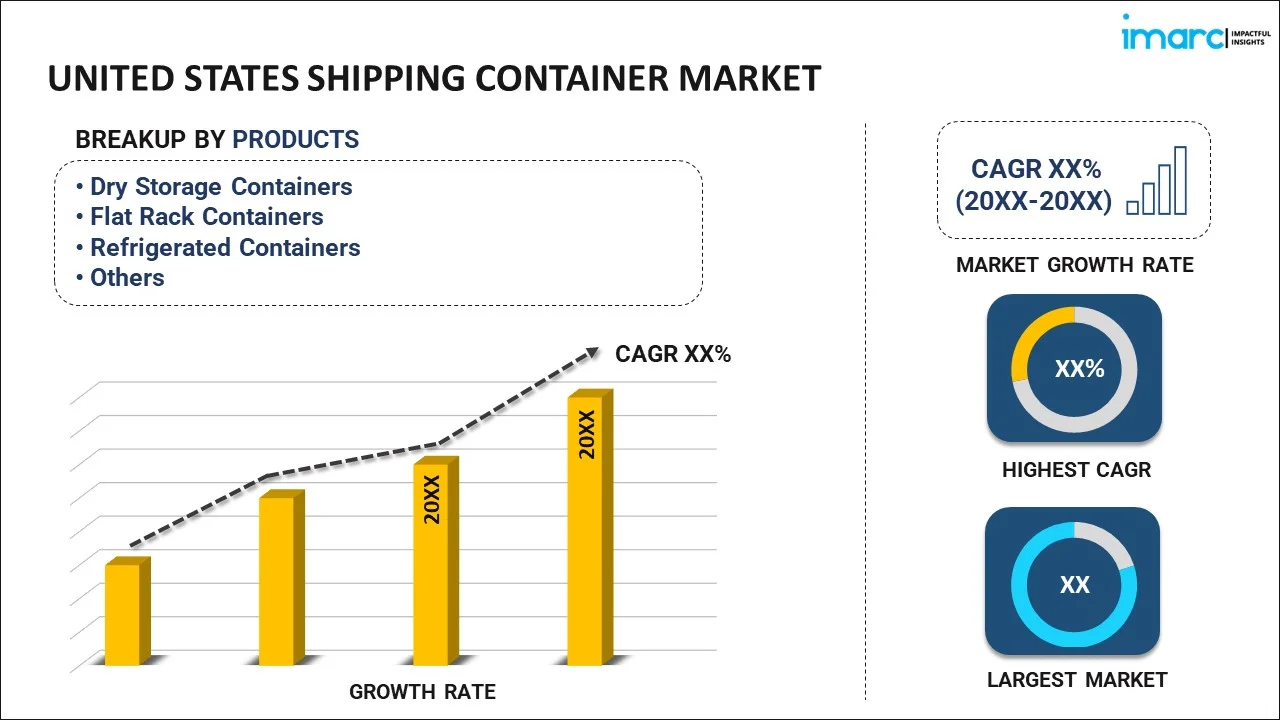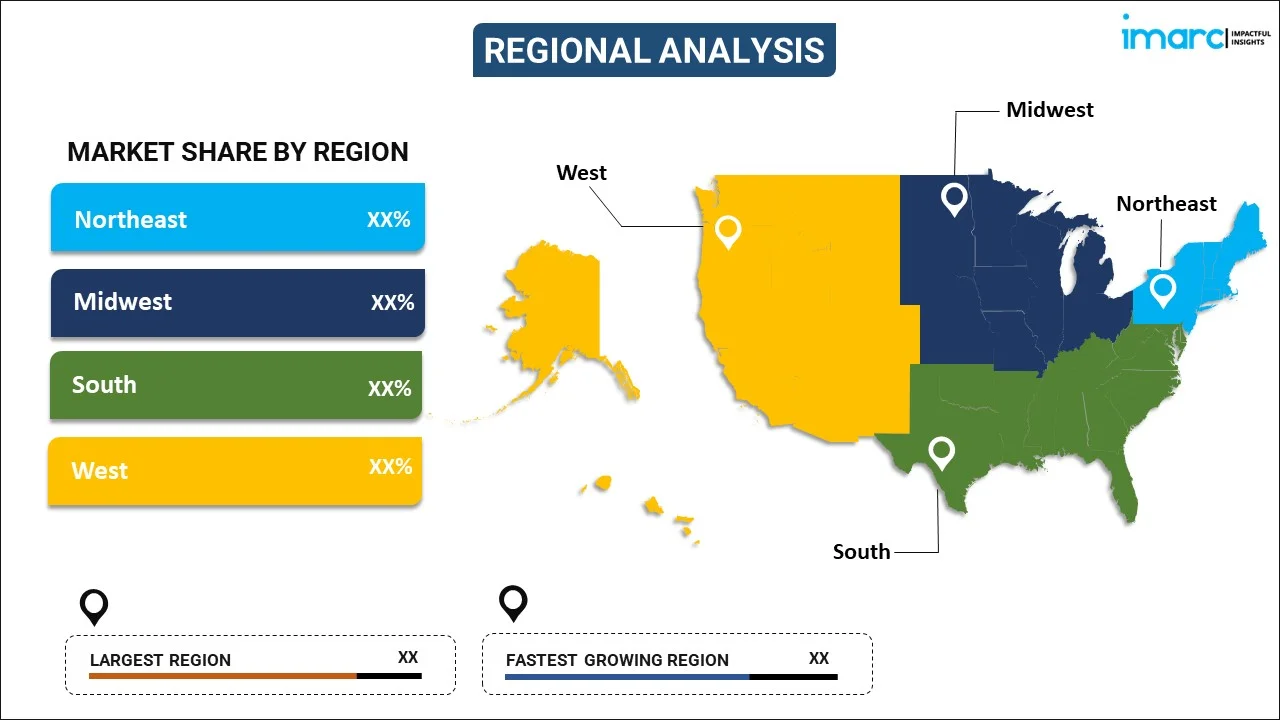
United States Shipping Container Market Report by Product (Dry Storage Containers, Flat Rack Containers, Refrigerated Containers, Special Purpose Containers, and Others), Container Size (Small Containers (20 feet), Large Containers (40 feet), High Cube Containers, and Others), Application (Food and Beverages, Consumer Goods, Healthcare, Industrial Products, Vehicle Transport, and Others), and Region 2025-2033
Market Overview:
The United States shipping container market size reached USD 1.7 Billion in 2024. Looking forward, IMARC Group expects the market to reach USD 2.8 Billion by 2033, exhibiting a growth rate (CAGR) of 5.4% during 2025-2033. The growing international trade across the region, the widespread adoption of shipping containers to withstand harsh weather conditions and protect goods from theft, damage, and environmental, and the significant expansion of e-commerce and online channels represent some of the key factors driving the market.
|
Report Attribute
|
Key Statistics
|
|---|---|
|
Base Year
|
2024
|
|
Forecast Years
|
2025-2033
|
|
Historical Years
|
2019-2024
|
| Market Size in 2024 | USD 1.7 Billion |
| Market Forecast in 2033 | USD 2.8 Billion |
| Market Growth Rate 2025-2033 | 5.4% |
A shipping container, is a standardized metal box developed for the efficient storage and transportation of goods across numerous modes of transportation, including ships, trucks, and trains. These containers are transforming the global logistics industry, providing a cost-effective and secure means of transporting goods worldwide. They are available in several standard sizes, with the most common being the 20-foot and 40-foot varieties. They are typically produced from high-strength steel and have a uniform design that allows for easy stacking and handling. The standardized dimensions of these containers ensure compatibility with various transport equipment, such as container ships, trucks, and cranes. They can accommodate numerous cargoes, consumer goods, electronics, raw materials, and industrial equipment. The interior of a container is often empty, providing ample space for goods to be loaded and secured, which helps protect the cargo from external elements and theft during transit. Additionally, shipping containers have become the backbone of international trade, facilitating the movement of goods between countries and continents, which simplifies the loading and unloading process at ports and terminals, reducing the time and labor required for handling cargo. Additionally, the security features of containers, such as locking mechanisms and tamper-evident seals, ensure the integrity of the goods inside.
United States Shipping Container Market Trends:
The market is primarily driven by the growing international trade. In addition, the escalating demand for efficient and reliable transportation of goods led to the adoption of shipping containers, providing a standardized and secure means of moving products, and facilitating international trade, which is influencing market growth. In addition, the extensive investment in port infrastructure and logistics and modern ports equipped to handle larger volumes of shipping containers are further streamlining the trade, thus influencing market growth. Moreover, the significant expansion in the e-commerce industry is escalating the demand for shipping containers, while online retailers rely on efficient logistics and transportation to deliver products to customers worldwide, representing another major growth-inducing factor. Besides this, the recent onset of the coronavirus disease (COVID-19) pandemic had positive impacts on the shipping container market, which accelerated the need for efficient and reliable transportation as businesses adapted to new demands, thus accelerating the market growth. Along with this, the increasing demand for shipping containers to withstand harsh weather conditions and protect goods from theft, damage, and environmental factors reassures businesses that their products will reach their destination intact, which is essential for high-value or sensitive cargo, further creating a positive market outlook across the United States.
United States Shipping Container Market Segmentation:
IMARC Group provides an analysis of the key trends in each segment of the market, along with forecasts at the country level for 2025-2033. Our report has categorized the market based on product, container size, and application.
Product Insights:

- Dry Storage Containers
- Flat Rack Containers
- Refrigerated Containers
- Special Purpose Containers
- Others
The report has provided a detailed breakup and analysis of the market based on the product. This includes dry storage containers, flat rack containers, refrigerated containers, special purpose containers, and others.
Container Size Insights:
- Small Containers (20 feet)
- Large Containers (40 feet)
- High Cube Containers
- Others
A detailed breakup and analysis of the market based on the container size have also been provided in the report. This includes small containers (20 feet), large containers (40 feet), high cube containers, and others.
Application Insights:
- Food and Beverages
- Consumer Goods
- Healthcare
- Industrial Products
- Vehicle Transport
- Others
The report has provided a detailed breakup and analysis of the market based on the application. This includes food and beverages, consumer goods, healthcare, industrial products, vehicle transport, and others.
Regional Insights:

- Northeast
- Midwest
- South
- West
The report has also provided a comprehensive analysis of all the major regional markets, which include Northeast, Midwest, South, and West.
Competitive Landscape:
The market research report has also provided a comprehensive analysis of the competitive landscape. Competitive analysis such as market structure, key player positioning, top winning strategies, competitive dashboard, and company evaluation quadrant has been covered in the report. Also, detailed profiles of all major companies have been provided.
United States Shipping Container Market Report Coverage:
| Report Features | Details |
|---|---|
| Base Year of the Analysis | 2024 |
| Historical Period | 2019-2024 |
| Forecast Period | 2025-2033 |
| Units | Billion USD |
| Scope of the Report | Exploration of Historical Trends and Market Outlook, Industry Catalysts and Challenges, Segment-Wise Historical and Future Market Assessment:
|
| Products Covered | Dry Storage Containers, Flat Rack Containers, Refrigerated Containers, Special Purpose Containers, Others |
| Container Sizes Covered | Small Containers (20 feet), Large Containers (40 feet), High Cube Containers, Others |
| Applications Covered | Food and Beverages, Consumer Goods, Healthcare, Industrial Products, Vehicle Transport, Others |
| Regions Covered | Northeast, Midwest, South, West |
| Customization Scope | 10% Free Customization |
| Post-Sale Analyst Support | 10-12 Weeks |
| Delivery Format | PDF and Excel through Email (We can also provide the editable version of the report in PPT/Word format on special request) |
Key Questions Answered in This Report:
- How has the United States shipping container market performed so far and how will it perform in the coming years?
- What has been the impact of COVID-19 on the United States shipping container market?
- What is the breakup of the United States shipping container market on the basis of product?
- What is the breakup of the United States shipping container market on the basis of container size?
- What is the breakup of the United States shipping container market on the basis of application?
- What are the various stages in the value chain of the United States shipping container market?
- What are the key driving factors and challenges in the United States shipping container?
- What is the structure of the United States shipping container market and who are the key players?
- What is the degree of competition in the United States shipping container market?
Key Benefits for Stakeholders:
- IMARC’s industry report offers a comprehensive quantitative analysis of various market segments, historical and current market trends, market forecasts, and dynamics of the United States shipping container market from 2019-2033.
- The research report provides the latest information on the market drivers, challenges, and opportunities in the United States shipping container market.
- Porter's five forces analysis assist stakeholders in assessing the impact of new entrants, competitive rivalry, supplier power, buyer power, and the threat of substitution. It helps stakeholders to analyze the level of competition within the United States shipping container industry and its attractiveness.
- Competitive landscape allows stakeholders to understand their competitive environment and provides an insight into the current positions of key players in the market.
Need more help?
- Speak to our experienced analysts for insights on the current market scenarios.
- Include additional segments and countries to customize the report as per your requirement.
- Gain an unparalleled competitive advantage in your domain by understanding how to utilize the report and positively impacting your operations and revenue.
- For further assistance, please connect with our analysts.
 Inquire Before Buying
Inquire Before Buying
 Speak to an Analyst
Speak to an Analyst
 Request Brochure
Request Brochure
 Request Customization
Request Customization




.webp)




.webp)












